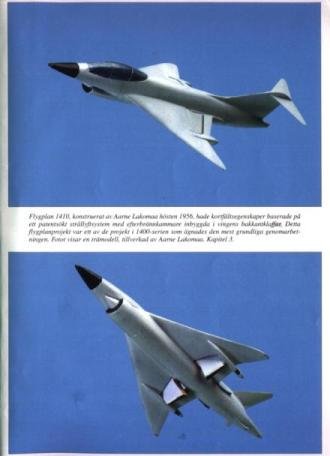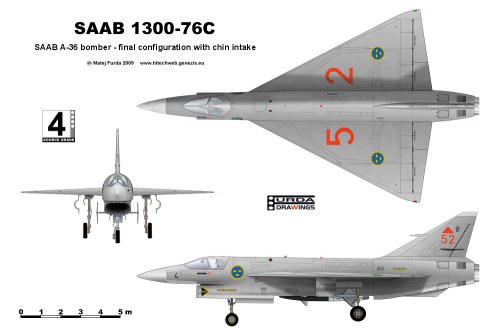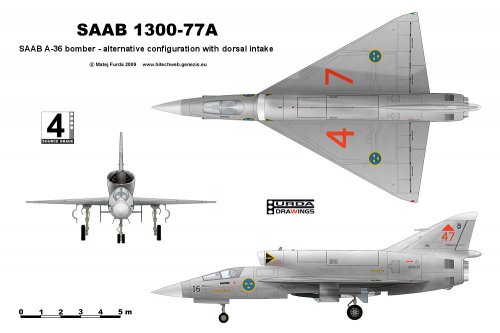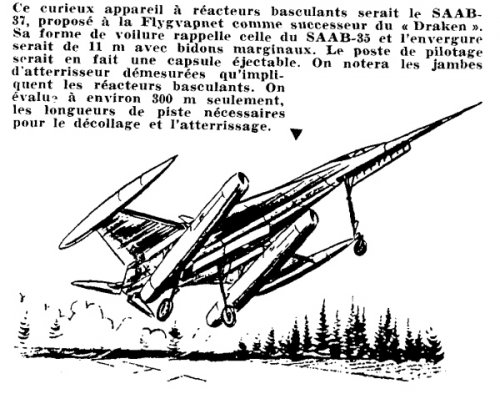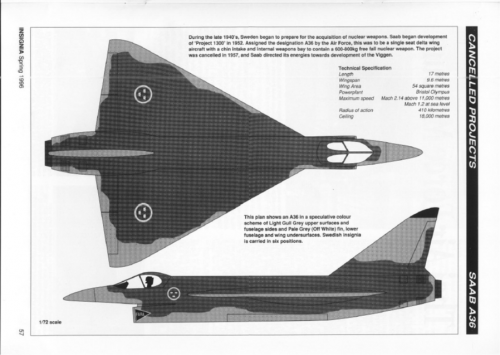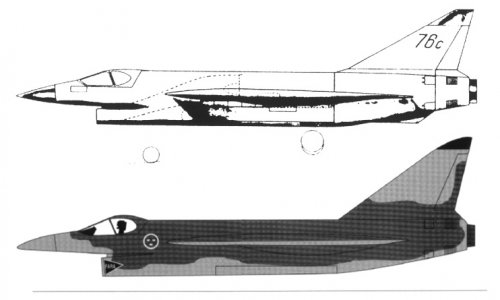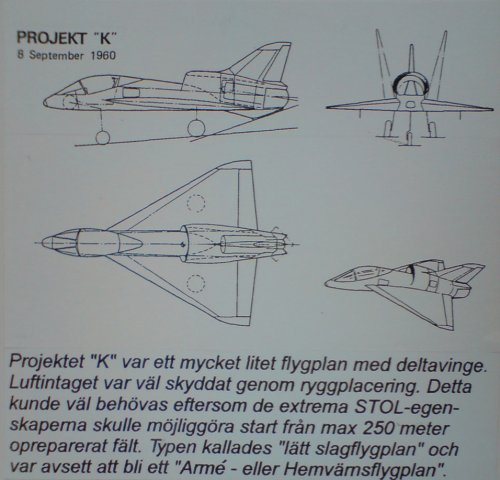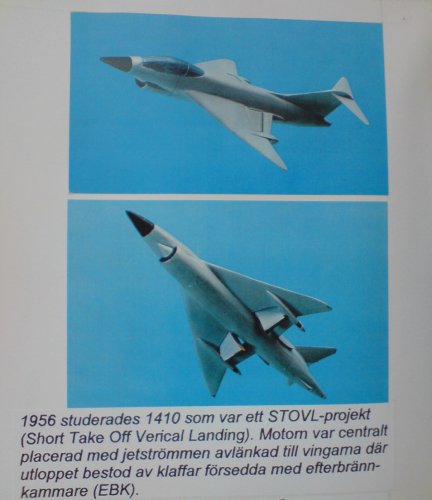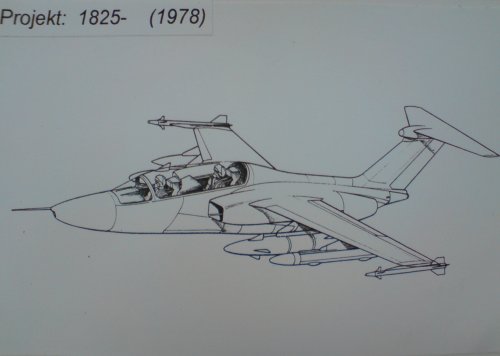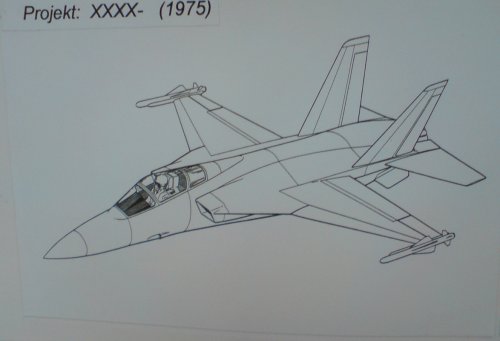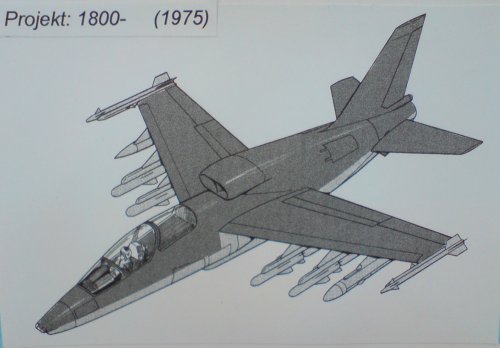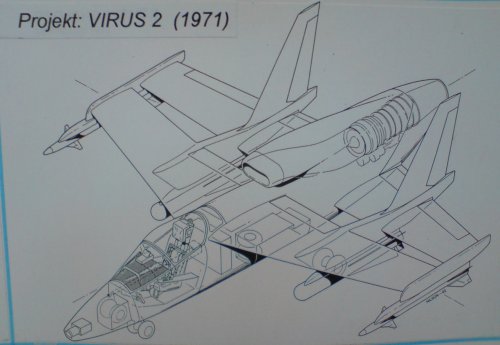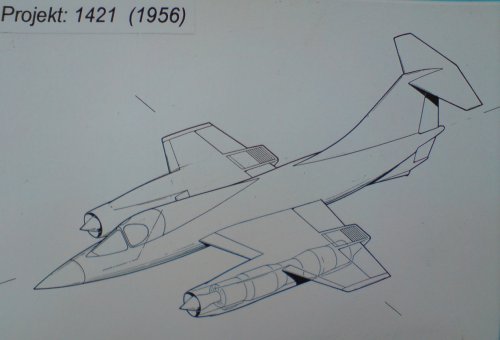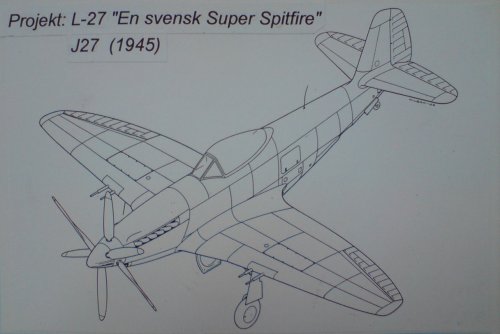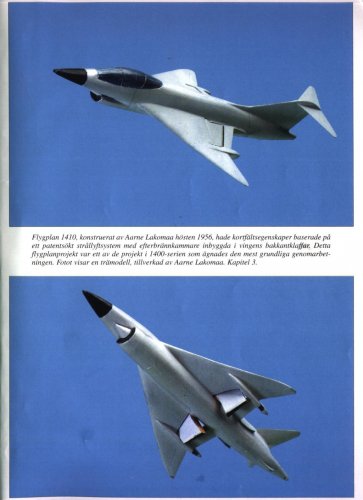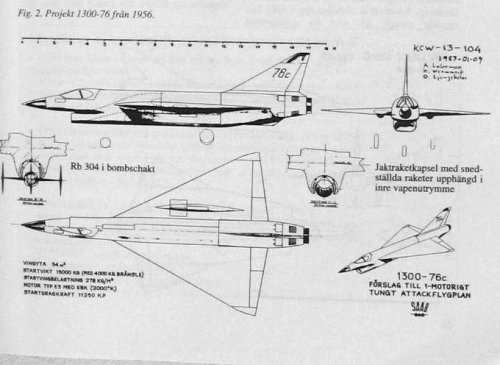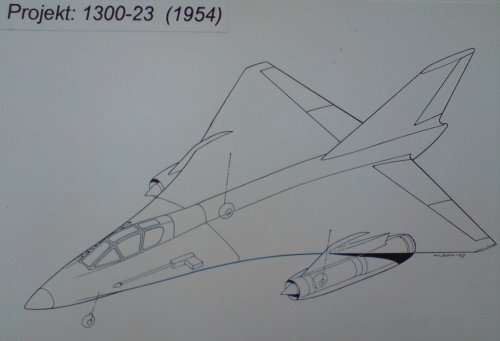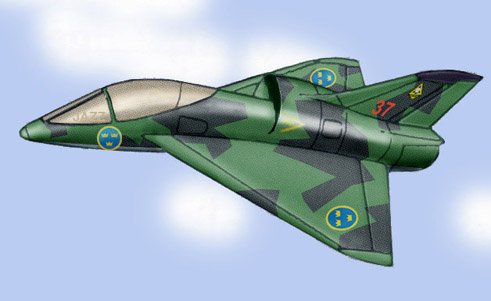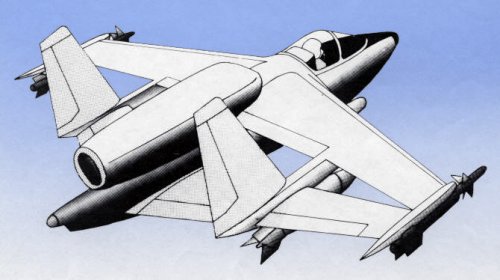You are using an out of date browser. It may not display this or other websites correctly.
You should upgrade or use an alternative browser.
You should upgrade or use an alternative browser.
SAAB Fighter / Attack projects
- Thread starter rousseau
- Start date
Matej
Multiuniversal creator
Thank you. I thought that it will be something from Dassault, but I was also in the secret hope that probably it could be SAAB 1443 a Mirage Mach 2,3 lookalike fighter. Well, one solved, three other projects remaining.
Matej
Multiuniversal creator
I just received the tip for the Holy Grail of the Swedish aviation projects. Lars Sundin from Swedish Aviation Historical Society forum forwarded me to the book:
Krister Karling: "Saab 37 Viggen. Utvecklingen av ett nytt enhetsflygplan för det svenska flygvapnet 1952-1971". ISBN 91-631-2395-9, published in 2002, that seems to be packed with the quantum of the unbuilt unique projects.
http://libris.kb.se/bib/8461987
Does anybody have access to this book or at least to the Swedish libraries where it is stored and is able at least to take a look, if there is any info about U-plan project? Or if anybody has this book and can sell it, than despite my current financial instability I am really considering to buy it.
Krister Karling: "Saab 37 Viggen. Utvecklingen av ett nytt enhetsflygplan för det svenska flygvapnet 1952-1971". ISBN 91-631-2395-9, published in 2002, that seems to be packed with the quantum of the unbuilt unique projects.
http://libris.kb.se/bib/8461987
Does anybody have access to this book or at least to the Swedish libraries where it is stored and is able at least to take a look, if there is any info about U-plan project? Or if anybody has this book and can sell it, than despite my current financial instability I am really considering to buy it.
Attachments
Matej
Multiuniversal creator
Tramtararaaa! For the first time ever (I think) the A-36 bomber has its own face. Included is also a slightly shorter alternative variant with the dorsal air intake. Thanks to Justo for the pictures that he share with us and thanks goes also to Jozef (planespictures), who gave me the additional material.
Attachments
Hammer Birchgrove
ACCESS: Top Secret
- Joined
- 13 May 2009
- Messages
- 583
- Reaction score
- 36
Firefly said:Sweden had atom bombs?
We didn't, the Government gave up on it when USA promised to protect us under its "nuclear umbrella" and Sweden signed the Non-Proliferation Treaty in the early 70's. Some "protection research" might have continued. The A-36 project was stopped before the stop of the atom bomb program actually, so if we had the atom bomb in the 70's it would be used for artillery shells. Both the atom bomb and its bomber would have taken money from Saab AJS 37 Viggen (which was actually USA's main concern!).
There was also some research in chemical warfare, that would have been more realistic. There was also a "paper" project for a nuclear
(sub-hunting) submarine with some innovative tech' to reduce noise, but it was decided it would be too expensive and not needed for the Baltic Sea.
Anyways, typicaly Swedish to find alternative roles for dedicated types.
That's academic since it never left the paper.
- Joined
- 2 August 2006
- Messages
- 3,169
- Reaction score
- 1,138
The alternative configuration you show has a dorsal intake. A ventral intake is like that shown in the original design.
Dorsal = on it's "back/top"
Ventral = On it's "belly/bottom"
I'm just nit picking as I know for many here, english isn't even their first language. Nice three view renders, thanks for sharing.
Dorsal = on it's "back/top"
Ventral = On it's "belly/bottom"
I'm just nit picking as I know for many here, english isn't even their first language. Nice three view renders, thanks for sharing.
Matej
Multiuniversal creator
Yay! Thanks, I corrected it.
agricola64
ACCESS: Confidential
- Joined
- 11 July 2006
- Messages
- 85
- Reaction score
- 8
Justo Miranda said:I have found some material on the SAAB A36 nuclear bomber posted at
http://www.secretprojects.co.uk/forum/index.php/topic,1177.0/highlight,saab+a-36.html
that it may be of general interest
was that nuclear weapon inteded to be a gun type assembly device .. ? it seems awfully lean for a first generation implosion device ..
Hammer Birchgrove
ACCESS: Top Secret
- Joined
- 13 May 2009
- Messages
- 583
- Reaction score
- 36
Justo Miranda said:I have found some material on the SAAB A36 nuclear bomber posted at
http://www.secretprojects.co.uk/forum/index.php/topic,1177.0/highlight,saab+a-36.html
that it may be of general interest
I read the text in the pictures, and it was mentioned that it instead of the bomb could be armed with the "Attackrobot 304" ("air-to-surface missile 304")* or with air-to-air unguided rockets. (Too many rockets to be nuclear-tipped a là Genie.)
*Most likely the same missile later known as "Robot 04", which was used on Saab A32 Lansen.
I wonder if Sweden would have had the capacity to make a stand-off missile, like the British Avro Blue Steel or France's ASMP. At least it seems to me that the A36 would useful at low-level missions.
Matej
Multiuniversal creator
Hammer Birchgrove said:I read the text in the pictures, and it was mentioned that it instead of the bomb could be armed with the "Attackrobot 304"...
It was not armed with the nuclear bomb, because such a device was never developed in Sweden, but the plane itself was designed for that purpose. For example it has semi-internal weapons bay because they feared, that the heat made by the air flow can make premature detonation. In my drawings it it armed with the anti ship missile Rb 04.
Hammer Birchgrove said:Firefly said:Sweden had atom bombs?
We didn't, the Government gave up on it when USA promised to protect us under its "nuclear umbrella" and Sweden signed the Non-Proliferation Treaty in the early 70's. Some "protection research" might have continued. The A-36 project was stopped before the stop of the atom bomb program actually, so if we had the atom bomb in the 70's it would be used for artillery shelves. Both the atom bomb and its bomber would have taken money from Saab AJS 37 Viggen (which was actually USA's main concern!).
There was also some research in chemical warfare, that would have been more realistic. There was also a "paper" project for a nuclear
(sub-hunting) submarine with some innovative tech' to reduce noise, but it was decided it would be too expensive and not needed for the Baltic Sea.
Anyways, typicaly Swedish to find alternative roles for dedicated types.
That's academic since it never left the paper.
Very Interresting, and I stand corrected.
Hammer Birchgrove
ACCESS: Top Secret
- Joined
- 13 May 2009
- Messages
- 583
- Reaction score
- 36
Matej said:Hammer Birchgrove said:I read the text in the pictures, and it was mentioned that it instead of the bomb could be armed with the "Attackrobot 304"...
It was not armed with the nuclear bomb, because such a device was never developed in Sweden, but the plane itself was designed for that purpose. For example it has semi-internal weapons bay because they feared, that the heat made by the air flow can make premature detonation. In my drawings it it armed with the anti ship missile Rb 04.
Thanks.
ysi_maniac
ACCESS: Confidential
- Joined
- 26 January 2007
- Messages
- 81
- Reaction score
- 30
Kind of a frogfoot. ???
shedofdread
ACCESS: Top Secret
- Joined
- 14 November 2009
- Messages
- 582
- Reaction score
- 353
Interesting. Historically, how much info has been shared Sweden - UK, I wonder? I ask because the Grippen shows 'similarities' to some BAe studies as does that posted by B/B to the BAe P103. Though the P103 post dates the Swedish concept considerably.
S
S
negoshi8or
ACCESS: Restricted
- Joined
- 28 March 2009
- Messages
- 23
- Reaction score
- 15
In reply to Mat (better late than never) - your image is from "Flyghistorisk Revy #29 SAAB 21" on page 63. This book in swedish also has a page discussing the J-21B. The swedish text is below, along with a google translation:
Also, follow this link to a Heller 1:72 J-21A modded to a J-21B
http://www.hobbybokhandeln.net/wp-content/gallery/open-2010-ac2/303_open_2010.jpg
Google English text:
Already a propeller airplane version of the 21 showed a
great development, which incidentally has become distinctive
for later-day Saab aircraft. By relatively
small design changes would not only performance
be improved but also the driver's ability to make
arise in a dogfight against the aircraft at mit.
ten-forties did the major aircraft manufacturers
production line. The project was called J 21 B. That there
came to the execution was due to jet engine - or reamotorn
as it was then known - more and more came to catch
Air Force and SAAB's intreste. J 21B was a project
who stayed on the paper but the design solution is
yet so interesting that it should not be withheld. It was
verging on that version came to fruition ...
Responsible for the design was a Saab engineer Ragnar
Curing Soil as a description of cost calculation, 3
September 1945 with the designation KF-21B-13 carrying
their thoughts. He observed that 21 B
would differ from J 21 A-2 mainly through the redesign
of the body with heavier armament in the nose (three
20 mm Bofors automatic cannon), new cabin interiors and
significantly enhanced radio equipment, new and huvutformning
pressurized cabin. To implement the seal test was requested SAAB
the Air Force would set a J 22 available.
Hårdemark proposal was based inter alia on a dummy for
J 21 B which are finished in early summer 1945 and
inspected by representatives of the Fc and the Royal Academy. Flight Management
starting on 30 July. For dummy construction
SAAB requested an exemption for three carpenters during the then ongoing
engineering strike.
The new body would be made without longitudinal stiffeners
with the exception of some rail positions. The nose would
except weapons include an electric storage battery,
two oxygen bottles, two compressed air cylinders and a machine gun camera.
My body would consist of förarrum and
tank space, with decor in the cabin as the control terminal,
dashboard and instrument panel on the right side
would be completely new. The steps would u "TGA. Furthermore, the establishment
under the driver's seat a radiator for cabin heating, amplifiers
for radar and automatic control equipment of AGA-type.
The most striking change was a tear-drophuv
of about the same look as the Mustang, which
would give the driver run virtually around the horizon.
Some reconstructions on the landing gear was envisaged
also. HuvudstäIlet would be moved forward about. an inch
and nose wheel diameter increased to 600 mm. The fork and
pivots of nose gear would also be reviewed to compensate
for the changed landing characteristics that were expected
for 21 B. Some emphasis changes also contributed
to redesign the landing gear. In this respect, should experience
from A 21 A-3 have been recorded. The increased armament load
for this version was that the angle of attack at start
needed to be increased, which also came to the execution of the
definitive attack version of "A 21st
Changes in the Cockpit
Tail was found to have service allowances. The only
change was that the person skis which accompanied the right
boom, which means after an emergency landing, would be deleted. To
bring your skis to after a possible failure to reach
back to their lines went back in history.
Eg had B 4 Hawker Hart a "nödsats' enabling
to signalisten Matti Sundsten during the Finnish Winter War
where he was a Swedish volunteer unit F 19;
could be reunited with their own. The period between B 4
and 21 B, however, was long and personal skis had to be deleted
for the benefit of saved weight.
In the case of flight controls and hydraulics designated Curing Soil
following changes. Pedal switch and joystick would
moves up 140 mm, which would entail the amendment of certain
fixings. Reglageplinten was redesigned completely.
Eg would propeller de-icing and cleaning spark plugs controls
completely deleted. Main and nose wheel gear would be operated
with the same control valve. One of those days untested
feature was that the flap lever was fixed positions.
The wing would be essentially the same as the 21A-2.
The only modification was meant was the strengthening of
leash of body attachment and kroppskopplen
would be moved into. This meant, in turn strengthening the
the wing center beam. Until The gates were widened slightly to
to allow installation of radar in front of the right boom.
To the radar would operate thinking ~ tea was made to perform anterior
Part of the boom in plastic or baked wood.
Further mapping of appliances, etc. in the wing appears
of the project description in which you want them to be in
left wing position including sounding radio type QTY / PKG KKK, bomb rack
and fire extinguishers. The right wing would, in addition to radar,
allowed space for aircraft radio Fr VIII and its converters
and bomb racks. On the outer wings were seized rocket stand
installed.
Motor
What is beyond the cap 21 B differed from earlier versions propeller
was the engine installation. In Hårdemark proposal
covered engine Daimler-Benz 605B. In early discussions
including Packard Merlin engine with five-blade propeller and
later developed the Daimler-Benz 605E. Engine Installation
for 21 B DB 605B meant, for instance new fuel tank,
new chilled water tank, new oil tank with bullet-proof, new engine plates,
no propeller protection and an amended attachment point
for the engine which had led to the forging at the upper knee
on the motor bracket must be modified.
Other changes from the A-version was to
auto gyro sight would be included, and NS-equipment.
Typkostnaden was estimated at 2.4 million crowns in 1945
stability. Total covered an order of 180 pcs J 21 B
with a delivery rate of 12 airplanes a month.
The exterior was therefore the main changes mo ·
Torin installation of new engine covers and a whole new hood
of teardrop-type. The project never came to execution
SAAB because at that time, in late 1945, received
promise reamotorn the HaviIland Goblin. Construction Work
was interrupted by a letter from Royal. Flight Management
to Saab on 9 November 1945.
How reamotorprojektet came to be implemented is a completely
different story and is portrayed elsewhere in this paper.
21 B, which was a very promising project under the future
conditions, would therefore draw the short straw for that
later became the Air Force song: readrift.
Swedish text:
Redan propellerversionen av flygplan 21 uppvisade en
stor utvecklingspotential, något som för övrigt blivit utmärkande
för senare tiders Saab-flygplan. Genom relativt
små konstruktionsförändringar sKulle inte bara prestanda
kunna förbättras utan även förarens möjligheter att göra
sig gällande i luftstrid gentemot de flygplan som vid mit.
ten av fyrtiotalet lämnade de stora flygplanstillverkarnas
produktionsband. Projektet kallades J 21 B. Att det inte
kom till utförande berodde på att jetmotorn - eller reamotorn
som den då kallades - allt mera kom att fånga
flygvapnets och SAAB:s intreste. J 21B blev ett projekt
som stannade på papperet men konstruktionslösningen är
ändå så intressant att den inte bör undanhållas. Det var
snudd på att versionen kom till förverkligande ...
Ansvarig för konstruktionen var Saab-ingenjören Ragnar
Härdmark som i en beskrivning för kostnadskalkyl den 3
september 1945 med beteckningen KF-21B-13 redovisade
sina funderingar. Han konstaterar inledningsvis att 21 B
skulle skilja sig från J 21 A-2 huvudsakligen genom omkonstruktion
av kroppen med kraftigare beväpning i nosen (tre
st 20 mm Bofors automatkanoner), ny kabininredning och
betydligt utökad radioutrustning, ny huvutformning samt
tryckkabin. För att genomföra tätningsprov hade SAAB begärt
att flygvapnet skulle ställa en J 22 till förfogande.
Härdmarks förslag grundade sig bl.a. på en attrapp för
J 21 B som färdigställts under försommaren 1945 och som
besiktigades av representanter för Fc och Kungl. Flygförvaltningen
med början den 30 juli. För attrappbyggandet
begärde SAAB dispens för tre snickare under den då pågående
verkstadstrejken.
Den nya kroppen skulle göras utan längsgående förstyvningar
med undantag för vissa relingspositioner. Nosen skulle
förutom beväpning innehålla ett elektriskt ackumulatorbatteri,
två syrgasflaskor, två tryckluftsflaskor samt en kulsprutekamera.
Mittkroppen skulle bestå av förarrum och
tankutrymme, varvid inredningen i kabinen såsom reglageplint,
instrumentbräda och instrumentpanelen på höger sida
skulle göras helt nya. Stegen skulle u"tgå. Vidare tillkom
under förarstolen en radiator för kabinuppvärmning, förstärkare
för radar samt styrautomatutrustning av AGA-typ.
Den mest iögonenfallande förändringen var en tear-drophuv
av ungefär samma utseende som på Mustang, vilken
skulle ge föraren sikt i stort sett horisonten runt.
Vissa omkonstruktioner beträffande landningsstället förutsågs
även. HuvudstäIlet skulle flyttas fram ca. en decimeter
och noshjulets diameter ökas till 600 mm. Gaffeln och
pivoten för nosstället skulle också göras om för att kompensera
för de förändrade landningsegenskaper som förväntades
för 21 B. Vissa tyngdpunktsförändringar bidrog också
till landningsställets omkonstruktion. Härvid torde erfarenheter
från A 21 A-3 ha spelat in. Den utökade beväpningslasten
för denna version gjorde att anfallsvinkeln vid start
behövde ökas, något som också kom till utförande i den
slutliga attackversionen av A 21.
Förändrad förarkabin
Stjärtpartiet bedömdes inte behöva omändras. Den enda
förändringen var att de personskidor som medfördes i högra
bommen som hjälp efter nödlandning, skulle utgå. Att
medföra skidor för att efter ett eventuellt haveri kunna ta sig
tillbaka till egna linjer gick tillbaka tidigare i historien.
Bl.a. hade B 4 Hawker Hart en sådan "nödsats" som möjliggjorde
att signalisten Matti Sundsten under finska vinterkriget,
där han ingick i svenska frivilligförbandet F 19,
kunde återförenas med de egna. Utvecklingen mellan B 4
och 21 B var emellertid lång och personskidorna fick utgå
till förmån för sparad vikt.
När det gällde styrorgan och hydraulik anvisade Härdmark
följande förändringar. Pedalställ och styrspak skulle
flyttas upp 140 mm vilket skulle medföra ändring av vissa
infästningar. Reglageplinten skulle omkonstrueras helt.
Bl.a. skulle propelleravisnings- och tändstiftsrengöringsreglage
helt utgå. Huvud- och noshjulsställ skulle manövreras
med samma manöverventil. En för den tiden oprövad
finess var att klaffreglaget fick fasta lägen.
Vingen skulle i huvudsak vara densamma som på 21A-2.
Den enda modifiering som avsågs var en förstärkning av
kopplet till kroppsinfästningen samt att kroppskopplen
skulle flyttas in. Detta innebar i sin tur en förstärkning av
vingens mittbalk. Frambommarna skulle breddas något för
att medge installation av radar i framkanten av höger bom.
För att radarn skulle verka tän~te man sig att utföra främre
delen av bommen i plexiglas eller bakat trä.
Ytterligare inplacering av apparater m.m. i vingen framgår
av projektbeskrivningen i vilken man tänkt sig att i
vänstervingen placera bl.a. pejlradio typ Frp KKK, bombställ
och eldsläckare. I högervingen skulle, förutom radarn,
medges utrymme för flygradio Fr VIII och dess omformare
samt bombställ. På yttervingarna skulle beslag för raketställ
installeras.
Motor
Det som utöver huven skilde 21 B från tidigare propellerversioner
var motorinstallationen. I Härdmarks förslag
avsågs motorn Daimler-Benz 605B. I början diskuterades
bl.a. Packard Merlin-motorn med fembladig propeller och
senare den utvecklade Daimler-Benz 605E. Motorinstallationen
för 21 B med DB 605B innebar bl.a. ny bränsletank,
ny kyltvätsketank, ny oljetank med skottskydd, nya motorplåtar,
inget propellerskydd samt en ändrad infästningspunkt
för motorn vilken hade inneburit att smidet vid övre knäet
på motorbocken måste ändras.
Andra förändringar jämfört med A-versionen var att
automatiskt gyrosikte skulle ingå samt IK-utrustning.
Typkostnaden beräknades till 2,4 milj kronor i 1945 års
penningvärde. Totalt avsågs en beställning om 180 st J 21 B
med en leveranstakt av 12 flygplan i månaden.
Exteriört var alltså de huvudsakliga förändringarna mo·
torinstallationen med nya motorkåpor samt en helt ny huv
av tear drop-typ. Projektet kom dock aldrig till utförande
eftersom SAAB vid denna tidpunkt, i slutet av 1945, fått
löfte om reamotorn de HaviIland Goblin. Konstruktionsarbetet
avbröts genom en skrivelse från Kungl. Flygförvaltningen
till SAAB den 9 november 1945.
Hur reamotorprojektet kom att genomföras är en helt
annan historia och skildras på annan plats i denna skrift.
21 B, som var ett mycket lovande projekt enligt den tidens
förutsättningar, skulle alltså få stryka på foten för det som
sedermera kom att bli flygvapnets melodi: readrift.
Also, follow this link to a Heller 1:72 J-21A modded to a J-21B
http://www.hobbybokhandeln.net/wp-content/gallery/open-2010-ac2/303_open_2010.jpg
Google English text:
Already a propeller airplane version of the 21 showed a
great development, which incidentally has become distinctive
for later-day Saab aircraft. By relatively
small design changes would not only performance
be improved but also the driver's ability to make
arise in a dogfight against the aircraft at mit.
ten-forties did the major aircraft manufacturers
production line. The project was called J 21 B. That there
came to the execution was due to jet engine - or reamotorn
as it was then known - more and more came to catch
Air Force and SAAB's intreste. J 21B was a project
who stayed on the paper but the design solution is
yet so interesting that it should not be withheld. It was
verging on that version came to fruition ...
Responsible for the design was a Saab engineer Ragnar
Curing Soil as a description of cost calculation, 3
September 1945 with the designation KF-21B-13 carrying
their thoughts. He observed that 21 B
would differ from J 21 A-2 mainly through the redesign
of the body with heavier armament in the nose (three
20 mm Bofors automatic cannon), new cabin interiors and
significantly enhanced radio equipment, new and huvutformning
pressurized cabin. To implement the seal test was requested SAAB
the Air Force would set a J 22 available.
Hårdemark proposal was based inter alia on a dummy for
J 21 B which are finished in early summer 1945 and
inspected by representatives of the Fc and the Royal Academy. Flight Management
starting on 30 July. For dummy construction
SAAB requested an exemption for three carpenters during the then ongoing
engineering strike.
The new body would be made without longitudinal stiffeners
with the exception of some rail positions. The nose would
except weapons include an electric storage battery,
two oxygen bottles, two compressed air cylinders and a machine gun camera.
My body would consist of förarrum and
tank space, with decor in the cabin as the control terminal,
dashboard and instrument panel on the right side
would be completely new. The steps would u "TGA. Furthermore, the establishment
under the driver's seat a radiator for cabin heating, amplifiers
for radar and automatic control equipment of AGA-type.
The most striking change was a tear-drophuv
of about the same look as the Mustang, which
would give the driver run virtually around the horizon.
Some reconstructions on the landing gear was envisaged
also. HuvudstäIlet would be moved forward about. an inch
and nose wheel diameter increased to 600 mm. The fork and
pivots of nose gear would also be reviewed to compensate
for the changed landing characteristics that were expected
for 21 B. Some emphasis changes also contributed
to redesign the landing gear. In this respect, should experience
from A 21 A-3 have been recorded. The increased armament load
for this version was that the angle of attack at start
needed to be increased, which also came to the execution of the
definitive attack version of "A 21st
Changes in the Cockpit
Tail was found to have service allowances. The only
change was that the person skis which accompanied the right
boom, which means after an emergency landing, would be deleted. To
bring your skis to after a possible failure to reach
back to their lines went back in history.
Eg had B 4 Hawker Hart a "nödsats' enabling
to signalisten Matti Sundsten during the Finnish Winter War
where he was a Swedish volunteer unit F 19;
could be reunited with their own. The period between B 4
and 21 B, however, was long and personal skis had to be deleted
for the benefit of saved weight.
In the case of flight controls and hydraulics designated Curing Soil
following changes. Pedal switch and joystick would
moves up 140 mm, which would entail the amendment of certain
fixings. Reglageplinten was redesigned completely.
Eg would propeller de-icing and cleaning spark plugs controls
completely deleted. Main and nose wheel gear would be operated
with the same control valve. One of those days untested
feature was that the flap lever was fixed positions.
The wing would be essentially the same as the 21A-2.
The only modification was meant was the strengthening of
leash of body attachment and kroppskopplen
would be moved into. This meant, in turn strengthening the
the wing center beam. Until The gates were widened slightly to
to allow installation of radar in front of the right boom.
To the radar would operate thinking ~ tea was made to perform anterior
Part of the boom in plastic or baked wood.
Further mapping of appliances, etc. in the wing appears
of the project description in which you want them to be in
left wing position including sounding radio type QTY / PKG KKK, bomb rack
and fire extinguishers. The right wing would, in addition to radar,
allowed space for aircraft radio Fr VIII and its converters
and bomb racks. On the outer wings were seized rocket stand
installed.
Motor
What is beyond the cap 21 B differed from earlier versions propeller
was the engine installation. In Hårdemark proposal
covered engine Daimler-Benz 605B. In early discussions
including Packard Merlin engine with five-blade propeller and
later developed the Daimler-Benz 605E. Engine Installation
for 21 B DB 605B meant, for instance new fuel tank,
new chilled water tank, new oil tank with bullet-proof, new engine plates,
no propeller protection and an amended attachment point
for the engine which had led to the forging at the upper knee
on the motor bracket must be modified.
Other changes from the A-version was to
auto gyro sight would be included, and NS-equipment.
Typkostnaden was estimated at 2.4 million crowns in 1945
stability. Total covered an order of 180 pcs J 21 B
with a delivery rate of 12 airplanes a month.
The exterior was therefore the main changes mo ·
Torin installation of new engine covers and a whole new hood
of teardrop-type. The project never came to execution
SAAB because at that time, in late 1945, received
promise reamotorn the HaviIland Goblin. Construction Work
was interrupted by a letter from Royal. Flight Management
to Saab on 9 November 1945.
How reamotorprojektet came to be implemented is a completely
different story and is portrayed elsewhere in this paper.
21 B, which was a very promising project under the future
conditions, would therefore draw the short straw for that
later became the Air Force song: readrift.
Swedish text:
Redan propellerversionen av flygplan 21 uppvisade en
stor utvecklingspotential, något som för övrigt blivit utmärkande
för senare tiders Saab-flygplan. Genom relativt
små konstruktionsförändringar sKulle inte bara prestanda
kunna förbättras utan även förarens möjligheter att göra
sig gällande i luftstrid gentemot de flygplan som vid mit.
ten av fyrtiotalet lämnade de stora flygplanstillverkarnas
produktionsband. Projektet kallades J 21 B. Att det inte
kom till utförande berodde på att jetmotorn - eller reamotorn
som den då kallades - allt mera kom att fånga
flygvapnets och SAAB:s intreste. J 21B blev ett projekt
som stannade på papperet men konstruktionslösningen är
ändå så intressant att den inte bör undanhållas. Det var
snudd på att versionen kom till förverkligande ...
Ansvarig för konstruktionen var Saab-ingenjören Ragnar
Härdmark som i en beskrivning för kostnadskalkyl den 3
september 1945 med beteckningen KF-21B-13 redovisade
sina funderingar. Han konstaterar inledningsvis att 21 B
skulle skilja sig från J 21 A-2 huvudsakligen genom omkonstruktion
av kroppen med kraftigare beväpning i nosen (tre
st 20 mm Bofors automatkanoner), ny kabininredning och
betydligt utökad radioutrustning, ny huvutformning samt
tryckkabin. För att genomföra tätningsprov hade SAAB begärt
att flygvapnet skulle ställa en J 22 till förfogande.
Härdmarks förslag grundade sig bl.a. på en attrapp för
J 21 B som färdigställts under försommaren 1945 och som
besiktigades av representanter för Fc och Kungl. Flygförvaltningen
med början den 30 juli. För attrappbyggandet
begärde SAAB dispens för tre snickare under den då pågående
verkstadstrejken.
Den nya kroppen skulle göras utan längsgående förstyvningar
med undantag för vissa relingspositioner. Nosen skulle
förutom beväpning innehålla ett elektriskt ackumulatorbatteri,
två syrgasflaskor, två tryckluftsflaskor samt en kulsprutekamera.
Mittkroppen skulle bestå av förarrum och
tankutrymme, varvid inredningen i kabinen såsom reglageplint,
instrumentbräda och instrumentpanelen på höger sida
skulle göras helt nya. Stegen skulle u"tgå. Vidare tillkom
under förarstolen en radiator för kabinuppvärmning, förstärkare
för radar samt styrautomatutrustning av AGA-typ.
Den mest iögonenfallande förändringen var en tear-drophuv
av ungefär samma utseende som på Mustang, vilken
skulle ge föraren sikt i stort sett horisonten runt.
Vissa omkonstruktioner beträffande landningsstället förutsågs
även. HuvudstäIlet skulle flyttas fram ca. en decimeter
och noshjulets diameter ökas till 600 mm. Gaffeln och
pivoten för nosstället skulle också göras om för att kompensera
för de förändrade landningsegenskaper som förväntades
för 21 B. Vissa tyngdpunktsförändringar bidrog också
till landningsställets omkonstruktion. Härvid torde erfarenheter
från A 21 A-3 ha spelat in. Den utökade beväpningslasten
för denna version gjorde att anfallsvinkeln vid start
behövde ökas, något som också kom till utförande i den
slutliga attackversionen av A 21.
Förändrad förarkabin
Stjärtpartiet bedömdes inte behöva omändras. Den enda
förändringen var att de personskidor som medfördes i högra
bommen som hjälp efter nödlandning, skulle utgå. Att
medföra skidor för att efter ett eventuellt haveri kunna ta sig
tillbaka till egna linjer gick tillbaka tidigare i historien.
Bl.a. hade B 4 Hawker Hart en sådan "nödsats" som möjliggjorde
att signalisten Matti Sundsten under finska vinterkriget,
där han ingick i svenska frivilligförbandet F 19,
kunde återförenas med de egna. Utvecklingen mellan B 4
och 21 B var emellertid lång och personskidorna fick utgå
till förmån för sparad vikt.
När det gällde styrorgan och hydraulik anvisade Härdmark
följande förändringar. Pedalställ och styrspak skulle
flyttas upp 140 mm vilket skulle medföra ändring av vissa
infästningar. Reglageplinten skulle omkonstrueras helt.
Bl.a. skulle propelleravisnings- och tändstiftsrengöringsreglage
helt utgå. Huvud- och noshjulsställ skulle manövreras
med samma manöverventil. En för den tiden oprövad
finess var att klaffreglaget fick fasta lägen.
Vingen skulle i huvudsak vara densamma som på 21A-2.
Den enda modifiering som avsågs var en förstärkning av
kopplet till kroppsinfästningen samt att kroppskopplen
skulle flyttas in. Detta innebar i sin tur en förstärkning av
vingens mittbalk. Frambommarna skulle breddas något för
att medge installation av radar i framkanten av höger bom.
För att radarn skulle verka tän~te man sig att utföra främre
delen av bommen i plexiglas eller bakat trä.
Ytterligare inplacering av apparater m.m. i vingen framgår
av projektbeskrivningen i vilken man tänkt sig att i
vänstervingen placera bl.a. pejlradio typ Frp KKK, bombställ
och eldsläckare. I högervingen skulle, förutom radarn,
medges utrymme för flygradio Fr VIII och dess omformare
samt bombställ. På yttervingarna skulle beslag för raketställ
installeras.
Motor
Det som utöver huven skilde 21 B från tidigare propellerversioner
var motorinstallationen. I Härdmarks förslag
avsågs motorn Daimler-Benz 605B. I början diskuterades
bl.a. Packard Merlin-motorn med fembladig propeller och
senare den utvecklade Daimler-Benz 605E. Motorinstallationen
för 21 B med DB 605B innebar bl.a. ny bränsletank,
ny kyltvätsketank, ny oljetank med skottskydd, nya motorplåtar,
inget propellerskydd samt en ändrad infästningspunkt
för motorn vilken hade inneburit att smidet vid övre knäet
på motorbocken måste ändras.
Andra förändringar jämfört med A-versionen var att
automatiskt gyrosikte skulle ingå samt IK-utrustning.
Typkostnaden beräknades till 2,4 milj kronor i 1945 års
penningvärde. Totalt avsågs en beställning om 180 st J 21 B
med en leveranstakt av 12 flygplan i månaden.
Exteriört var alltså de huvudsakliga förändringarna mo·
torinstallationen med nya motorkåpor samt en helt ny huv
av tear drop-typ. Projektet kom dock aldrig till utförande
eftersom SAAB vid denna tidpunkt, i slutet av 1945, fått
löfte om reamotorn de HaviIland Goblin. Konstruktionsarbetet
avbröts genom en skrivelse från Kungl. Flygförvaltningen
till SAAB den 9 november 1945.
Hur reamotorprojektet kom att genomföras är en helt
annan historia och skildras på annan plats i denna skrift.
21 B, som var ett mycket lovande projekt enligt den tidens
förutsättningar, skulle alltså få stryka på foten för det som
sedermera kom att bli flygvapnets melodi: readrift.
- Joined
- 3 June 2006
- Messages
- 2,828
- Reaction score
- 2,489
Matej
Multiuniversal creator
Hammer Birchgrove
ACCESS: Top Secret
- Joined
- 13 May 2009
- Messages
- 583
- Reaction score
- 36
Returning to this thread, I like to add that A32 Lansen and perhaps A37 Viggen would have gotten tactical nukes and mustard gas bombs if such weapons had been put to service here. The light strike version of Sk 60 would have been armed with tanks and sprays for the nerve gas sarin; kinda like crop dusters... :-\Hammer Birchgrove said:Matej said:Hammer Birchgrove said:I read the text in the pictures, and it was mentioned that it instead of the bomb could be armed with the "Attackrobot 304"...
It was not armed with the nuclear bomb, because such a device was never developed in Sweden, but the plane itself was designed for that purpose. For example it has semi-internal weapons bay because they feared, that the heat made by the air flow can make premature detonation. In my drawings it it armed with the anti ship missile Rb 04.
Thanks.
Hammer Birchgrove
ACCESS: Top Secret
- Joined
- 13 May 2009
- Messages
- 583
- Reaction score
- 36
I dunno; it reminds me of Mirage IV.Stargazer2006 said:Gosh! Another case of reality being stranger than fiction... What an ungainly bird!!
Three-view drawing of Saab Project K circa 1960.
Source:
http://rilleman.blogspot.com/2008/07/de-som-aldrig-flg.html
Source:
http://rilleman.blogspot.com/2008/07/de-som-aldrig-flg.html
Attachments
Saab Project 1410 STOVL Mach 2 fighter circa 1956.
Source:
http://rilleman.blogspot.com/2008/07/de-som-aldrig-flg.html
Source:
http://rilleman.blogspot.com/2008/07/de-som-aldrig-flg.html
Attachments
Artist's impression of Saab Project 1825.
Source:
http://rilleman.blogspot.com/2008/07/de-som-aldrig-flg.html
Source:
http://rilleman.blogspot.com/2008/07/de-som-aldrig-flg.html
Attachments
Artist's impression of Saab Project XXXX
Source:
http://rilleman.blogspot.com/2008/07/de-som-aldrig-flg.html
Source:
http://rilleman.blogspot.com/2008/07/de-som-aldrig-flg.html
Attachments
Artist's impression of Saab Project 1800. Predecessor or variant of Saab B3LA?
Source:
http://rilleman.blogspot.com/2008/07/de-som-aldrig-flg.html
Source:
http://rilleman.blogspot.com/2008/07/de-som-aldrig-flg.html
Attachments
Artist impression of Saab VIRUS 2.
Source:
http://rilleman.blogspot.com/2008/07/de-som-aldrig-flg.html
Source:
http://rilleman.blogspot.com/2008/07/de-som-aldrig-flg.html
Attachments
- Joined
- 9 October 2009
- Messages
- 19,766
- Reaction score
- 10,213
[Whistles]
The Saab Project 1421 was a proposed Mach 2.6 replacement for the Saab Draken.
Artist's impression of Saab Project 1421.
Source:
http://rilleman.blogspot.com/2008/07/de-som-aldrig-flg.html
http://u-fr.blogspot.com/2010/12/saab-aircraft-projects-brief-list-with.html
Artist's impression of Saab Project 1421.
Source:
http://rilleman.blogspot.com/2008/07/de-som-aldrig-flg.html
http://u-fr.blogspot.com/2010/12/saab-aircraft-projects-brief-list-with.html
Attachments
Artist's impression of Saab J27.
Source:
http://rilleman.blogspot.com/2008/07/de-som-aldrig-flg.html
Source:
http://rilleman.blogspot.com/2008/07/de-som-aldrig-flg.html
Attachments
Models of Saab Project 1410.
Source:
http://forum3.sff.n.se/viewtopic.php?f=1&t=1595&p=8621&hilit=hitechweb
Source:
http://forum3.sff.n.se/viewtopic.php?f=1&t=1595&p=8621&hilit=hitechweb
Attachments
Similar threads
-
Saab Viggen concepts and unbuilt versions
- Started by Pioneer
- Replies: 38
-
Design development of the SAAB JAS 39 Gripen
- Started by arc3371
- Replies: 45
-
SAAB, Svenska Aeroplanaktiebolaget, Svenska Aeroplan AB, Saab AB aircraft list.
- Started by blockhaj
- Replies: 39
-
What if Sweden/Saab went for a different set of design criteria for the Gripen
- Started by helmutkohl
- Replies: 31
-

